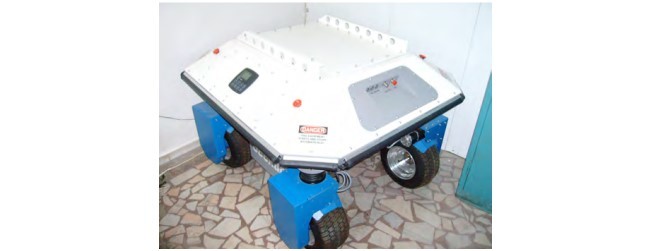
دانلود رایگان مقاله کنترل کننده لغزشی به منظور هدایت نقلیه چهار چرخ

چکیده
یک روش حل به منظور کنترل لغزشی وسیله ی چهار چرخ در این مقاله ارائه شده است. مزیت این نوع کنترل کننده نسبت به روش ها ی قبلی در واقع کاربردش در انواع بیشتری از وسایل چرخ دار است که هر دوی وسایل تک هدایت شونده و دو هدایت شونده را شامل می شود. همانطور که در نتایج شبیه سازی نشان داده شده است روش لغزشی حل را نسبت به خطاها و نوسانات قوی تر می کند.
1. مقدمه
برای مدت زیادی کنترل ربات های غیر هولونمیک زمینه ی تحقیقاتی بسیار فعالی بوده است. حداقل 2 دلیل برای این موضوع وجود دارد . تشکیل دادن بسیاری از امکانات حمل و نقل از این وسایل چرخ دار است اولین دلیل آن است. بر خلاف گذشته که این وسایل محدود به آزمایشگاههای تحقیقاتی و کارخانه ها بود اکنون این وسایل به بخش مهمی از زندگی روزمره تبدیل شده است فارغ از کاربرد های نظامی. از نظر دیگر معادلات سینتیکی وسیله ی غیر هولونومیک به شدت غیر خطی هستند . بعضی از روش های به منظور ارتقای بقیه ی سیستم های فیزیکی توسعه داده شده است.
تحقیقات در زمینه ی مدل کردن و کنترل ربات های چرخ دار به دو قسمت اصلی تقسیم می شوند. یکی از انها معطوف اتوموبیل ها و قطار میشوند و دیگری معطوف به ربات های درونی چرخ دار می شوند. این تقسیم بندی بر پایه ی تفاوت در طراحی ربات ها و شرایط کارکرد و محیطی است. وابستگی مکانیکی چرخ ها در ربات ها منجر به طراحی آسان تر وسایل دو چرخ یا ماشین های چهار چرخ می شوند. در مدل کردن و کنترل ربات های کنترل از راه دور هدایت مستقل به وسیله ی چرخ ها لازم است که تاثیر هر کدام از چرخ ها به طور مستقل در نظر گرفته شود. اگر چه کنترل کننده ها در این کار ها با فرض جفت بودن در هنگام لغزش طراحی می شوند.
این مقاله با مدل سینماتیکی Seekur برگرفته شده از روش تولید ربات ها ی کنترل از راه دور سرو کار دارد.
ربات های بیرونی با همان مشکلات ربات های درونی ، از جمله حس گر ها ، آنالیز اطلاعات ، جابجایی ، هدایت و ارتباط با اطراف است. در ربات های بیرونی پیش بینی می شود بیشتر این مشکلات در محیط های خاصی همچون محیط های غیر منظم همچون جنگل ها و بیابان ها و حتی محیط های کشاورزی دیده شود.
کنترل ساختاری متغیر(VSC) به منظور کنترل قدرتمند تر در کاربرد هایی همچون کنترل پرواز ، کنترل موتور های الکتریکی ، تنظیم فرآیند های شیمیایی و پایداری هلیکوپتر ها ، سیستم های فضایی کاربرد دارد. یکی از انواع خاص VCS ، روش کنترل کننده ی لغزشی می باشد. تئوری SMC از زمانی که معلوم شد که این روش غیر خطی کنترل کردن شامل ویژگیهایی از جمله قدرتمند بودن در مقابل پارامتر های تغییرات است ، در سیستم ها ی کنترلی مختلف استفاده می شود. با طراحی توابع تغییر حالت یا توابع متغیر های خروجی ،SMC می تواند تضمین کننده ی نگهداشتن ربات در مسیر توسط تابع تغییر می باشد که منجر به دست یابی به سیستم دینامیکی مورد نظر است. ویژگی اصلی استفاده از SMC شامل پاسخ سریع ، انتقال خوب و قدرتمند بودن نسبت به عدم قطعیت ها و اغتشاشات بیرونی است.
مدل های کنترلی ربات های چهار چرخ مبتنی بر کنترل سینماتیکی با چند چرخ لغزشی در دهه اخیر مورد توجه عموم قرار گرفته است. کنترل کننده هایی که از مدل های دینامیکی پیشرفته ربات های چهار چرخ استفاده می کنند ، در عمل و به دلیل دشواری های محاسباتی مرتبط با جنبه ی های آنالیزی ویژگیهایشان استفاده نمی شوند.
این بهبود نمودن در کنترل منجر به مانور پذیری در سرعت های کم و منجر به کاهش اختلاف اندازه گیری در مسیر یابی به واسطه ی قرار دادن زاویه ی چرخ ها ی عقب در زاویه ایی خلاف با چرخ های جلو است. در سرعت های بالا سیستم لغزشی چهار چرخ ، قرار دادن تمامی چرخ ها در یک زاویه منجر به پایداری بیشتر وسیله ی مورد نظر می شود.
A. مدل سینماتیکی
به منظور بحث در مورد سینماتیک غیر هولونومیک فرضیات زیر مورد توجه هستند:
فاصله ی بین چرخ ها (محور) به شکل دقیقی ثابت هستند.
محور لغزش هر چرخ بر سطح عمود است.
در کل وسیله هیچ بخش انعطاف پذیری وجود ندارد.
Abstract
A solution to trajectory-tracking control problem for a four-wheel-steering vehicle (4WS) is proposed using sliding-mode approach. The advantage of this controller over current control procedure is that it is applicable to a large class of vehicles with single or double steering and to a tracking velocity that is not necessarily constant. The sliding-mode approach make the solutions robust with respect to errors and disturbances, as demonstrated by the simulation results.
I. INTRODUCTION
For many years, the control of non-holonomic vehicles has been a very active research field. At least two reasons account for this fact. On one hand, wheeled vehicles constitute a major and ever more ubiquitous transportation system. Previously restricted to research laboratories and factories, automated wheeled vehicles are now envisioned in everyday life (e.g. through car-platooning applications or urban transportation services), not to mention the military domain. On the other hand, the kinematic equations of non-holonomic systems are highly nonlinear, and thus of particular interest for the development of nonlinear control theory and practice. Furthermore, some of the control methods initially developed for non-holonomic systems have proven to be applicable to other physical systems (e.g. underactuated mechanical systems), as well as to more general classes of nonlinear systems.
Research on modelling and control of wheeled vehicles can be divided into two major categories: one that is oriented towards automobiles and terrain vehicles, the other is oriented towards indoor wheeled mobile robots (WMRs). This classification is based on the differences in the design of the vehicles, operational and environmental conditions. Mechanical coupling of the wheels in vehicles often allows the use of a simplified, single-track model of two-wheelsteering and four-wheel-steering cars for the design of motion controllers. In modelling and control of mobile robots with independently steered and/or driven wheels it is required to explicitly account for each of the wheels of the vehicle. However the controllers in these works are still design under the assumption that the wheels are steered in pairs.
This paper deals with the kinematics model and the feedback control of an autonomous wheeled robot named Seekur (Fig.1) from the Mobile Robots Inc [1].
Outdoor robots face all of the same challenges as indoor robots, such as sensing, data processing, locomotion, navigation, and interaction with the surroundings. Outdoor robots, however, are expected to achieve all of these things in much more complex and unstructured environments such as forests, deserts, and even agricultural fields [2]-[5].
Variable structure control (VSC) has been showing to be a robust approach in different applications and has been successfully applied in control problems as diverse as automatic flight control, control of electric motors, regulation in chemical processes, helicopter stability augmentation, space systems and robotics. One particular type of VCS system is the sliding mode control (SMC) methodology [6]. The theory of SMC has been applied to various control systems, since it has been shown that this nonlinear type of control exhibits some excellent properties, such as robustness against large parameter variation and disturbances [7], [8]. By designing switch functions of state variables or output variables to form sliding surfaces, SMC can guarantee that when trajectories reach the surfaces, the switch functions keep the trajectories on the surfaces, thus yielding the desired system dynamics. The main advantages of using SMC include fast response, good transient and robustness with respect to system uncertainties and external disturbances.
Kinematics-based control of 4WS vehicle with multiple steering wheels has received considerable attention over the last decade. Controllers that utilize complex dynamic model of the 4WS vehicle are not used in practice due to their computational infeasibility and difficulties related to analytical investigation of their properties.
Recent research and development has shown that fourwheel steering systems can effectively improve the handling behavior of vehicles. These handling improvements provide better maneuverability at low speeds and reduce the delay in path tracking by setting the rear wheel steering angle in the direction opposite to the front wheel steering angle. At high speeds, four-wheel steering systems improve vehicle stability by turning all the wheel steering angles in the same direction.
A. Kinematics model
To discuss a nonholonomic kinematic model of a vehicle,the following assumptions are considered:
a) distances between wheels (generally called as wheelbase) are strictly fixed;
b) the steering axle of each wheel is perpendicular to a surface terrain;
c) a vehicle does not consist of any flexible parts.
چکیده
1. مقدمه
A. مدل سینماتیکی
2. كنترل وسیله نقلیه چهارچرخ
.A خطاهای مسیر یابی
.Bکنترل مدل لغزشی
3. نتایج شبیه سازی
4. نتیجه گیری
منابع
Abstract
1. INTRODUCTION
A. Kinematics model
2. CONTROL OF 4WS VEHICLE
A. Trajectory-tracking errors
B. Sliding-mode control
3. SIMULATION RESULTS
4. CONCLUSIONS
REFERENCES
